Why is the Swedish fly dangerous on winter wheat and how to deal with it and other pests of cereals
The fly is causing great serious damage to agriculture by destroying cereals and forage crops. This insect adapts to any environmental conditions: thanks to its high adaptive abilities, it has spread throughout the entire globe and is found even in the Arctic. Only a carefully thought-out system of measures to protect crops and adult plants helps to defeat a dangerous pest.
The content of the article
What is this pest
The Swedish fly is a representative of the family of cereal flies Chloropidae (Diptera order)... It was first described in Sweden by the first taxonomist Karl Linnaeus (1756). Now about 30 species of this insect are known.
What does it look like
In an adult, an elongated body measuring 1.5-2.5 mm is black.... In the female, the abdomen is more thickened, ending in a narrow ovipositor. Scutellum rounded; dorsum slightly convex, smooth.
The wings are small, transparent, with a metallic sheen. On the head there is a small proboscis and black antennae.
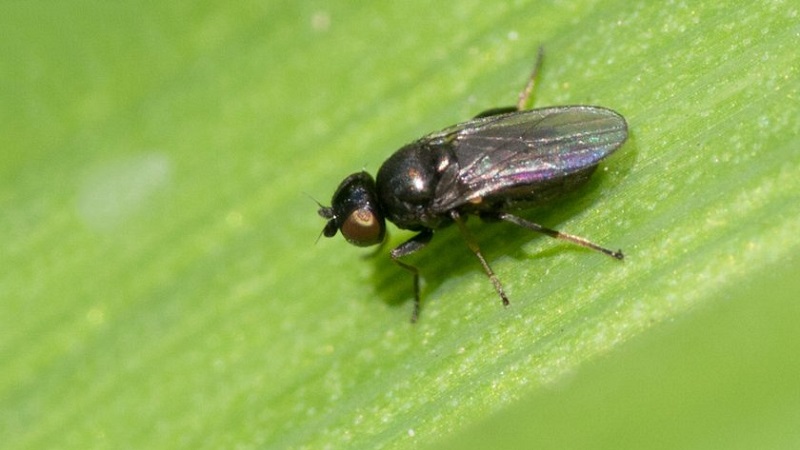
What is dangerous for winter wheat
The main harm of the Swedish fly causes winter wheat in autumn... Flying out at the end of September, females lay eggs in the leaf axils of young shoots during the second leaf release. Then oviposition is suspended and usually stops after reaching 50% of the third leaf.
The hatched voracious larvae, which are twice the size of an adult, penetrate into the shoots at the base of the stem. There they eat up the path up, reaching the rudiment of an ear, eat it and milk grains.
If fry fly larvae damage the main stem, the crop dies, because of which the yield percentage is significantly reduced - by 50%.
Reference! The larvae of Swedish flies damage about 20 species of cultivated and 46 species of wild-growing cereals.
Reproduction and life cycle
Pests multiply so quickly that in one season they manage to produce up to 5 generations of individuals in favorable weather. The female carefully chooses a suitable place. First, it checks all the stems by stroking them with its antennae, and then lays eggs in cereals that have reached a certain stage of vegetation. The size of the eggs is 0.7-0.8 mm.
The larvae inside the egg develop for about eight days., then go out in search of food. With the help of special salivary glands, which secrete a specific enzyme for breaking down plant tissues, they absorb the rudiments of future wheat grains.
In nature, the life cycle of larvae is about a month. with sufficient nutrition, under laboratory conditions - up to 40 days. They are kept without food for a maximum of seven days.
The insect spends winter in hibernation in the form of a pupa in the stubble of perennial grasses and on seedlings of winter crops. It becomes more active with the arrival of spring at temperatures above + 12 ° С.
It can be useful:
Reasons for the appearance
The main reason for its ubiquitous appearance is the ability to adapt to different climates.... There are other factors contributing to the spread of the population on winter wheat:
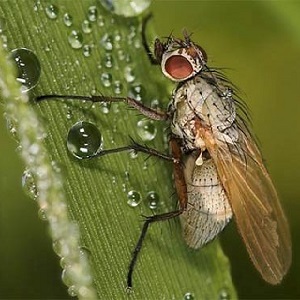 Long warm autumn... The period of sabotage increases (at a temperature of + 10 ° C, the insect already hibernates).
Long warm autumn... The period of sabotage increases (at a temperature of + 10 ° C, the insect already hibernates).- Aridity... Dry weather promotes active growth and development of larvae.
- Food conditions for the growth of winter crops. The more food enters the plant, the stronger it is, the stages of development occur much faster. Consequently, in the Swedish fly, the period of eating the plant is shortened, since it harms at a certain phase of the growing season of the crop.
- Favorable temperature for the period of larval growth (above +10 ° C).
- Insect ability to migrate over long distances.
Symptoms of defeat
First of all, the larvae affect the development of the stem... The central leaf withers and turns yellow, sometimes it is absent altogether: it either falls off or does not come out of the leaf sinus. Outward signs of damage caused by a swedish fly, come to lightabout two weeks from the larva settlement.
The plant tries to direct forces to the damaged areas, so the color of the leaves becomes intense green, and the stems thicken. Experts on this basis unmistakably determine the presence of the Swedish fly in wheat fields.
Control methods
The harm caused to insects can be significantly reduced with the right choice of means to combat it.
Agrotechnical
The most effective ways:
- Compliance with crop rotation... The best predecessors: legumes (clover, alfalfa, peas, soybeans, vetch-oat mixture), corn, annual herbs except sorghum and Sudanese grass. It is not advisable to sow wheat in one area for more than two years.
- Selection of sustainable seed with strong fiber that protects the ear from damage by larvae.
- Sowing late varieties (for example, Mirostan, Chaus, Krasnodol) at the optimal time so that winter crops begin to rise with the onset of frost, when flies hibernate.
- Increasing the seeding rate grain, so that most of the sprouted ears will survive and the harvest will remain at the same level.
- Deep plowing soil.
- Application of nitrogen fertilizers to fields with winter crops to increase the vitality of plants.
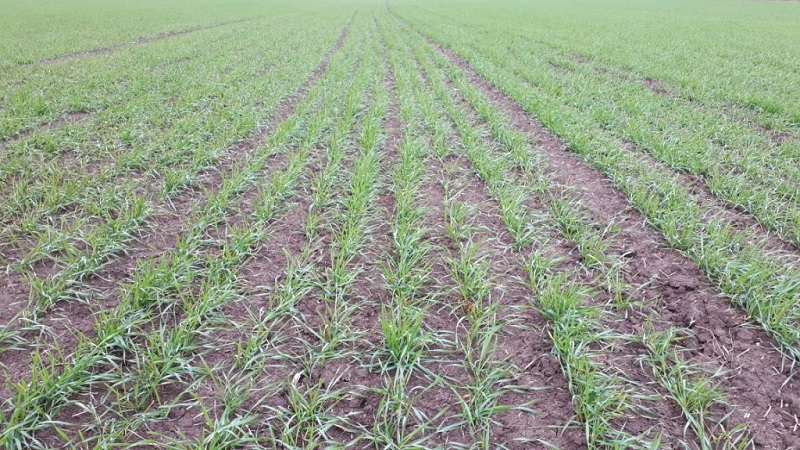
Chemical
During the period of egg laying and mass summer, chemical treatment of wheat is carried out... With the use of aviation, winter crops are pollinated when they are in the first leaf phase. In many localities, hexachlorane 12% dust is widely used.
The population of harmful insects is reduced when spraying plants with organochlorine and organophosphorus agents. Insecticidal preparations are also used, for example, "Cruiser" and "Celest Top".
Attention! The death of a fly after the treatment reaches 93%, the yield increases by 20% or more.
Preventive measures
To obtain a high yield, you need preventive actions:
- Timely peeling stubble to destroy the pest and its larvae.
- Sowing high-grade calibrated seeds. They give friendly and strong shoots, and such are more resistant to attacks of the Swedish fly.
- Grain pickling before sowing into the soil. Used drugs "Gaucho", "Cruiser".
- Sowing with cereals preferably placed after legumes or row crops.
Read also:
Fertilizers for winter wheat: how to feed in the fall
Other pests of winter wheat in seeds, plantings and warehouses
The number of pests of cereals is very high. Let's talk about the ones that do the most harm.
Bug turtle
The insect prefers to feed mainly on wheat, damaging both winter and spring crops.... Outwardly it looks like a tiny turtle. The development cycle of the bug is directly related to the growing season of cereals, therefore, throughout the summer period, the turtle leads an active lifestyle, causing significant damage both in the fields and in storage facilities.
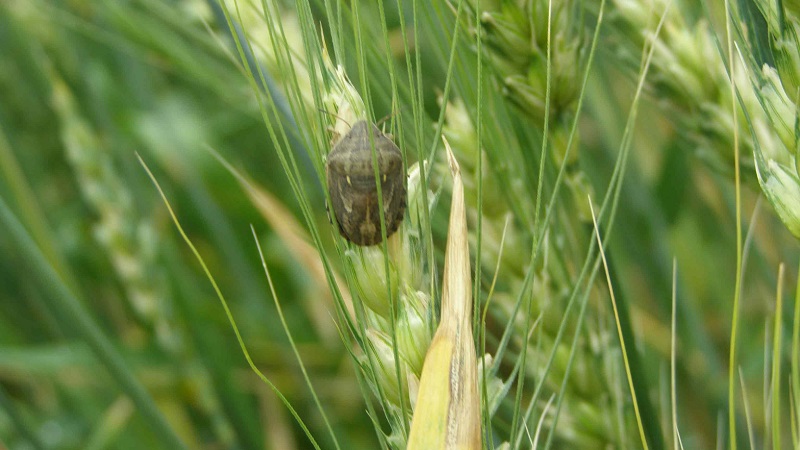
Thrips
Wheat thrips damages winter and spring wheat, as well as some cereal perennial grasses. Both adults and larvae are harmful.The insect feeds on fresh juice from the ears of the ears or from a young succulent leaf, as a result of which the cereal stops growing.
The grains in the ear receive severe damage - they become chipped, defective, which affects the overall quality of the seed. Outwardly, thrips is a small black-brown fly with poorly developed wings and a size of 1.3-1.5 mm.
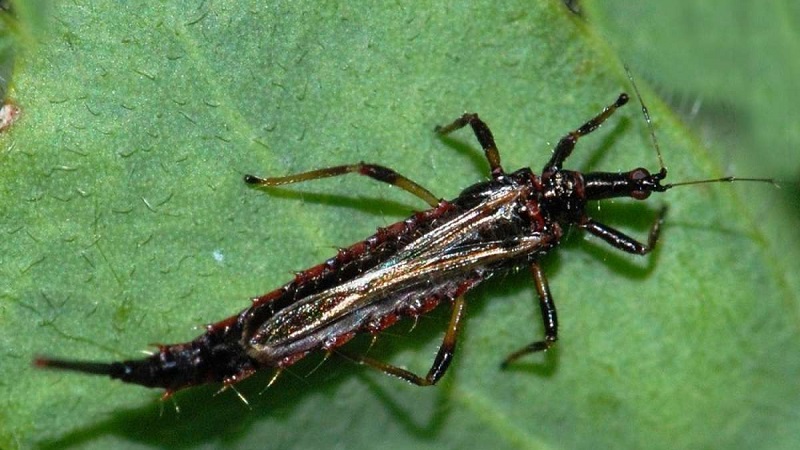
Ground beetle
Ground beetle inflicts the greatest harm on winter wheat... The larvae of this pest begin their activity during the period of raising and the beginning of tillering of seedlings. They eat leaves and young stems, turning wheat bushes into soaked fiber. Adult beetles attack the ears. They gnaw the scales of the spike, the rudiments of caryopses, gnaw out the ripening grains.
The size of the insect is 12-17 mm, the color is pitch black with a bronze sheen... The head is large, the antennae are short, the elytra are convex with deep punctate grooves.
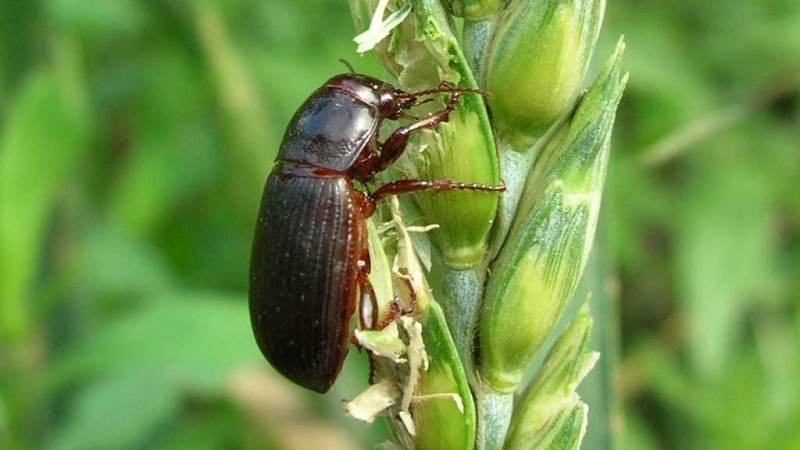
Weevil
The bugs mouth apparatus is an elongated proboscis... With its help, the insect destroys the dense skin of grain or cereals. The weevil is considered one of the main and most dangerous pests of grain crops - wheat, barley, buckwheat, corn, as well as pasta, and makes stocks unusable both in the kitchen and in huge grain storage facilities.
The insect has an elongated body about 4 mm in size, dark brown, almost black in color... In the presence of wings, it is not adapted to flight, however, it moves over long distances on ships and trains with industrial grain consignments.
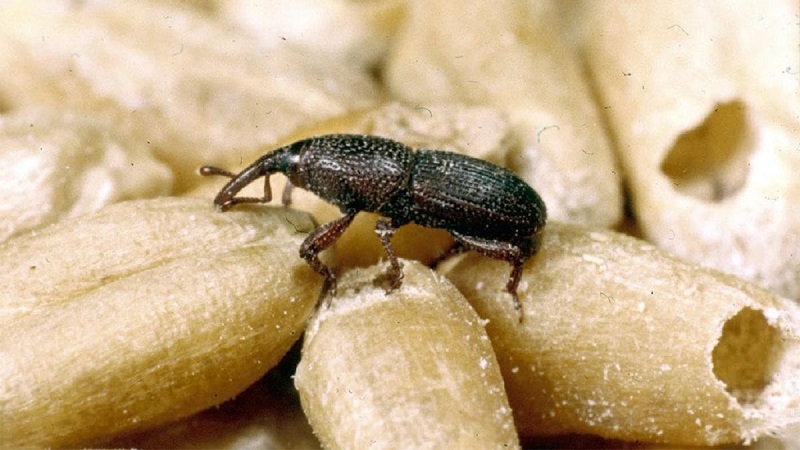
How to deal with wheat pests
Control measures for the listed pests and preventive procedures are held approximately the same and include:
- Agrotechnical measures: stubble plowing and deep autumn plowing, observance of crop rotation and sowing dates, cultivation of resistant varieties.
- Chemical: spraying grain with permitted types of insecticides, for example, "Karate", "Arrivo", "Fastak", "Aktelik".
- Preventive: before storing grain in storage, dressing of grain with means based on carbendazim, mancozeb, triticonazole. And also the maximum drying of the product, thorough cleaning of the room, disinfection of the storage, for example, with formalin vapor (after that, the storage is kept hermetically closed for 2-3 days, then thoroughly ventilated).
Conclusion
The Swedish fly and other insects that feed on winter wheat varieties can completely ruin the crop without timely protection measures. Preventing loss of crops, specialists in the complex carry out agrotechnical, chemical and preventive methods of pest control both in the fields and in grain storage facilities.